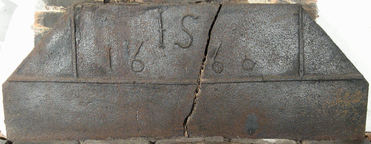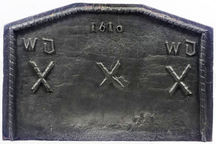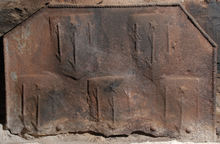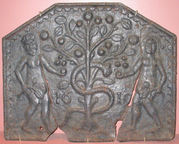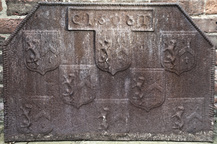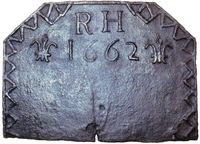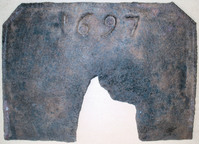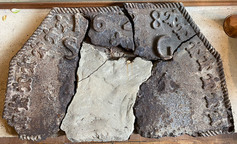-
837
Description: Canted rectangle; cavetto-moulded edging; three horizontal strips bearing a fine repeated ribbing: one horizontal below canted corners, and two vertical strips parallel to each side, dividing the fireback into two side panels, two top corner panels, top panel and main central panel; top corner panels, a plant stamp repeated in each; top panel, date between a repeated plant stamp; side panels, fleur-de-lys stamp repeated twice on each side in a vertical arrangement, a single plant stamp below, above an initial 'I' on the left and 'B' on the right; central panel plain.
Notes: The 'daisy' stamp, fleurs-de-lys and the IB initials are found on other backs in a distinct series. Illustration from Shuffrey 1912, p.139, and formerly part of the author's personal collection.
Inscription: 1710 / I B
- Decoration tags:
- rectangular with canted top corners (shape)
- cavetto (edging)
- carved stamps
- individual letters
- individual numbers
- heraldic
- text
- plants
Manufactured: in 1710 in the Forest of Dean area of England.
Current location: not known.
Citation: Shuffrey, L. A., 1912, The English Fireplace, London, Batsford.
- Attached to series:
- IB series
- Date only firebacks
-
690
Description: Canted rectangle; plain edges; broad horizontal fillet dividing the plate in two just above the side angles, with vertical fillets to top corners enclosing date and initials.
Notes: Uncharacteristically crude for the period.
Inscription: IS / 16 60
- Decoration tags:
- rectangular with canted top corners (shape)
- none (edging)
- simple stamps
- individual letters
- individual numbers
- text
Manufactured: in 1660 in the Weald area of England.
Current location: Smallhythe Place, Small Hythe Road, Tenterden, Kent, England.
Museum number: 1117951 (part of the National Trust museum group)
- Attached to series:
- Date & initials firebacks
-
892
Description: Canted rectangular shape; plain edging with inset ?leather strap twisted round dowel (top and sides); top centre, date probably in stamped numerals; twisted leather strap saltire repeated three times across middle of plate; pair of stamped initials, formed of a Roman 'W' and a Gothic 'd', above each outer saltire.
Notes: Sotheby's sale London 27 November 2006, lot 324; formerly at Brunger, Kent (near Tenterden).
Inscription: 1610 / WD WD
- Decoration tags:
- rectangular with canted top corners (shape)
- none (edging)
- simple stamps
- individual letters
- individual numbers
- apotropaic
- text
- objects
Manufactured: in 1610 in England.
Current location: not known.
- Attached to series:
- Date & initials firebacks
- Miscellaneous stamp firebacks
-
693
Description: Canted rectangle; twisted rope edging (top and sides); a shield repeated five times, each bearing three arrows palewise, points down, with a molet (star) above the middle arrow, two over three.
Notes: Three arrows form the arms of several families, so identification of the arms is not possible without the associated colouring. The star is likely to be a mark of cadency, granted to a third son. Four rivets along the base may relate to earlier repair. The fireback was formerly at Chisenbury Priory, Wiltshire. A variant with three shields (W 740mm x H 480mm) was lot 530 at Brettells auction, Newport, Salop, 1 March 2022 and again as lot 457 on 2 May 2023.
Arms: Not known
- Decoration tags:
- rectangular with canted top corners (shape)
- rope (edging)
- carved stamps
- armorial
Manufactured: in the late-16th to early-17th century in England.
Current location: Cothay Manor, Stawley, Somerset, England.
- Attached to series:
- Personal armorial firebacks
-
697
Description: Canted rectangle; embattled, cavetto moulded edging; central tree with fruit and leaves, a snake, facing right, with a human face in profile entwined, in ‘S’ shape, around the trunk and lower branches; to the left, a naked, bearded male figure holding an apple in his left hand and a branch in his right for modesty; to the right a naked female figure with apple and branch also; the date split either side of the snake and tree trunk.
Notes: Similarities with an armorial in the date, numerals and edging suggest a common pattern-maker.
Copies of this fireback are known.
Inscription: 16 19
- Decoration tags:
- rectangular with canted top corners (shape)
- embattled cavetto (edging)
- whole carved pattern
- pictorial
- biblical
- text
- animals
- humans
- plants
Manufactured: in 1619 in England.
Current location: Stroud District Museum, Stroud, Gloucestershire, England.
Museum number: STGC 2371 (part of the Stroud Museum museum group)
- Attached to series:
- 1619 series
- Old Testament & Apocrypha firebacks
- Adam & Eve firebacks
-
1167
Description: Canted quasi-rectangular shape; no edging; parallel with top edge, initials in triad to left, separated from date by a small, ill-defined flower stamp.
Notes: The serifed character set is boldly impressed, although the S is indistinct, suggesting that some of the moulding sand may have filled the impression before casting. The indentations on each side were cut to accommodate mouldings. Tennants Auctioneers sale, Leyburn, North Yorkshire, 20 March 2015, lot 781.
Inscription: ISM [triad] 1611
- Decoration tags:
- rectangular with canted top corners (shape)
- none (edging)
- individual letters
- individual numbers
- text
- plants
Manufactured: in 1611 in England.
Current location: not known.
- Attached to series:
- Date & initials firebacks
-
1315
Description: Canted rectangular shape; twisted rope edging (top and sides); top centre, rectangular panel with cavetto-moulded edging enclosing date between initials CT; below, eight shields of Ayloffe impaling Sulyard in three rows (3-2-3); Ayloffe: sable, a lion rampant Or, collared gules, between three crosses formy of the second; Sulyard: argent, a chevron gules between three pheons inverted sable.
Notes: William Ayloffe (c1535-1584) of Bretons, Hornchurch, Essex, Justice of the Court of Queen’s Bench, married (c1560) Jane, dau. of Sir Eustace Sulyard, of Runwell, Essex. The initials 'CT' are likely to be those of Charles Tyler, a founder whose working life and that of his family have strong parallels with the occurrence of these firebacks. The reversal of the second 6 in the date is, so far, unique in this series.
Inscription: C 1606 T [the second 6 reversed]
Arms: Ayloffe impaling Sulyard (William Ayloffe of Bretons, Hornchurch)
- Decoration tags:
- rectangular with canted top corners (shape)
- rope (edging)
- carved stamps
- individual letters
- individual numbers
- heraldic
- armorial
- text
Manufactured: in 1606 possibly at Bedgebury Furnace, Goudhurst in the Weald area of England.
Current location: in private hands, Tenterden, Kent, England.
- Attached to series:
- Ayloffe series
- Personal armorial firebacks
-
860
Description: Canted rectangle; fillet edging (top and sides); top centre, initials, above date, between repeated fleur-de-lys stamp; from top corners to bottom corners, repeated V-shape pattern formed of stamped short fillets, with an L-shape inserted between the top two Vs on each side.
Notes: The fleurs de lys are of a distinctive style seen on a small group of firebacks.
Inscription: RH / 1662
- Decoration tags:
- rectangular with canted top corners (shape)
- fillet (edging)
- simple stamps
- carved stamps
- individual letters
- individual numbers
- heraldic
- text
- objects
Manufactured: in 1662 in the Forest of Dean area of England.
Current location: not known.
- Attached to series:
- Date & initials firebacks
- Newent area group
-
861
Description: Canted rectangle; twisted rope edging (top and sides); top centre, date.
Inscription: 1697
- Decoration tags:
- rectangular with canted top corners (shape)
- rope (edging)
- carved stamps
- individual numbers
- text
Manufactured: in 1697 in England.
Current location: not known.
- Attached to series:
- Date only firebacks
-
1258
Description: Broken and fragmentary; canted quasi-rectangular shape, with sides inclined; twisted rope edging; top centre, date with initials below separated by a fleur-de-lys; seven fleurs-de-lys down each side, pints perpendicular to rope edging; a fleur beneath each initial, possibly other fleurs and another initial missing in between.
Notes: The fleurs-de-lys are of a distinctive form apparently unique to this series of firebacks.
Inscription: 1628 / S G
- Decoration tags:
- rectangular with canted top corners (shape)
- rope (edging)
- simple stamps
- carved stamps
- heraldic
- text
Manufactured: in 1628 in the Forest of Dean area of England.
Current location: 31 Long Street, Tetbury, Gloucestershire, England.
- Attached to series:
- 1620s Dean series
- Date & initials firebacks
 p139 fig 134.jpg)
